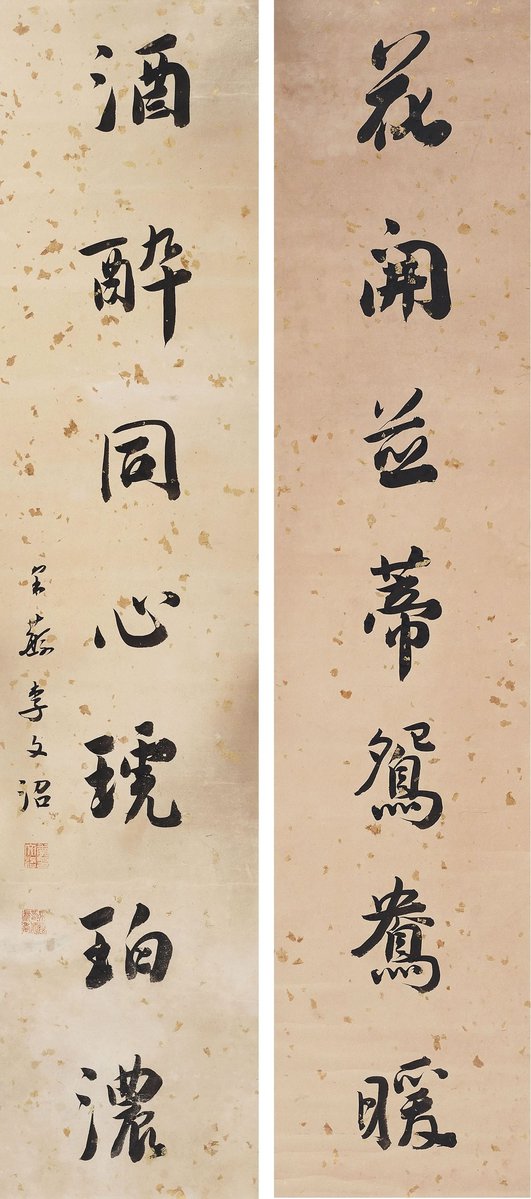

-
Details
- Place where the work was made
-
China
- Media categories
- Scroll , Calligraphy
- Materials used
- pair of hanging scrolls; ink on paper
- Dimensions
-
161.2 x 64.0 cm overall (variable)
:
a - right scroll, 109.5 x 24 cm, image
a - right scroll, 161.2 x 32 cm, scroll
b - left scroll, 109.5 x 24 cm, image
b - left scroll, 161.2 x 32 cm, scroll
- Signature & date
Signed l.l. part b, in Chinese, inscribed in black ink “Li Wenzhao."
Not dated.- Credit
- Gift of Dr. James Hayes 2003
- Location
- Not on display
- Accession number
- 308.2003.a-b
- Copyright
- Artist information
-
Li Wenzhao
Works in the collection
- Share
-
-
About
‘Twin flowering blooms warm a pair of mandarin ducks;
Intertwined hearts are intoxicated, reflected in an amber cup.’
Inscription and signature: Li Wenzhao.It was common practice (and still is in China) to send a couplet to relatives or friends on the occasion of a wedding, as exemplified by these lines. In Chinese literature, twin flowers on one stalk (or pedicel) symbolise a devoted couple. The pair of mandarin ducks is also a customary image of lovers.
Li Wenzhao (alias Caifan) was a native of Tianjing. Literary references to him are limited. We only know that he was the follower of Zhang Zhaoxiang (1852–1908), a famous Tianjing painter. Some of his paintings bear the date 1941, suggesting he was still active in the early 1940s.
‘The Poetic Mandarin: Chinese Calligraphy from the James Hayes Collection’. pg.130.
© 2005 Art Gallery of New South WalesThe couplet, written on two narrow pieces of paper or silk, and hung either side of a large painting or doorway, is one of the most common forms of calligraphic art and has a long standing history in China. They first appeared in the Five Dynasties period (907-979) as pairs of plaques, carved after written master copies, to decorate architectural columns, courtyards and garden doorways. Couplets for indoor display, written on paper or silk, came into existence in the 17th century and gained great popularity in the Qing dynasty. The couplets themselves are either taken from classical poetry or contemporary literary works composed by the calligraphers themselves and their friends. A couplet is made up of two parts called the head and the tail. The two lines of verse are antithetically parallel. Formerly it was a very common practice to send them to friends or relations on such occasions as marriages and birthdays, or as condolences to families of deceased persons.
Asian Art Department, AGNSW, August 2003.
-
Places
Where the work was made
China
-
Exhibition history
Shown in 2 exhibitions
The poetic mandarin: Chinese calligraphy from the James Hayes collection, Art Gallery of New South Wales, Sydney, 23 Sep 2005–27 Nov 2005
The Way We Eat, Art Gallery of New South Wales, Sydney, 03 Apr 2021–13 Jun 2022
-
Bibliography
Referenced in 2 publications
-
John Saxby, Look, 'Scripted drama', pp. 57-60, Sydney, Aug 2021-Sep 2021, 60 (colour illus.).
-
LIU Yang, The poetic mandarin: Chinese calligraphy from the James Hayes collection, Sydney, 2005, 130, 131 (illus.). cat.no. 42
-
